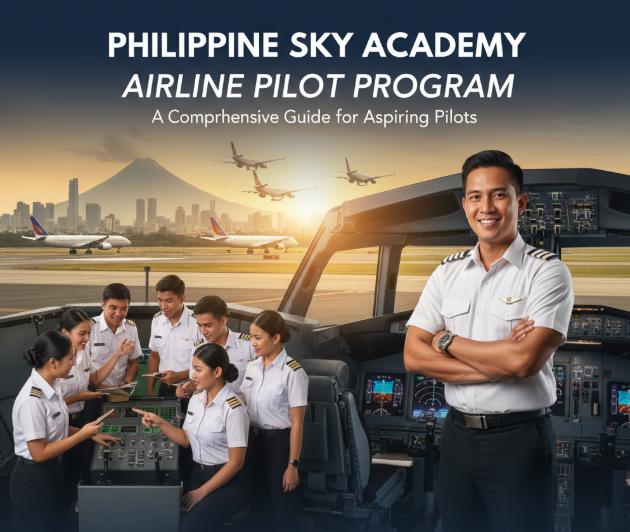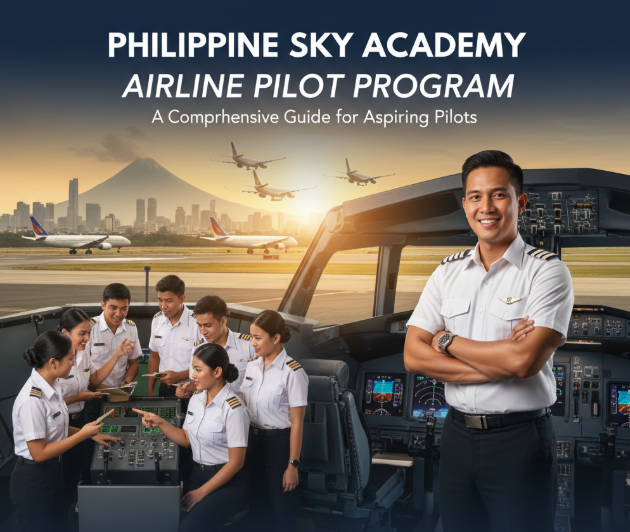
The aviation industry has long been one of the most sought-after career paths, especially in countries with thriving air travel sectors like the Philippines. The Philippines’ strategic geographic location, along with its growing aviation industry, makes it an ideal place for aspiring pilots to embark on a rewarding career. This blog post provides an in-depth look into the Airline Pilot Program in the Philippines, from its historical development to the future opportunities in the industry.
Introduction to Airline Pilot Program in the Philippines
An Airline Pilot Program refers to the structured education, training, and licensure process designed to produce professional pilots. This program is tailored to provide students with the necessary knowledge and skills to fly commercial aircraft, ensuring the safety and efficiency of air travel. In the Philippines, aviation has become a key industry, offering a range of pilot training options for aspiring aviators.
What is the Airline Pilot Program?
An Airline Pilot Program is a comprehensive training regimen that prepares individuals to fly commercial aircraft, either for domestic or international airlines. This program includes academic education, hands-on flight training, simulator experiences, and preparation for the necessary certifications required to become a licensed pilot. Pilot training in the Philippines adheres to international aviation standards and is recognized globally.
The Pilot Training Program typically spans several years, depending on the level of certification one aims for. It includes several stages, such as the Private Pilot License (PPL), Commercial Pilot License (CPL), and the Airline Transport Pilot License (ATPL), which are mandatory to fly larger commercial aircraft.
Importance of Aviation in the Philippines
The aviation sector in the Philippines plays a crucial role in both the local and international transport industries. As an archipelagic country with over 7,000 islands, the Philippines heavily relies on air travel for the movement of people, goods, and services.
The country has over 80 commercial airports, with major hubs located in cities such as Manila, Cebu, Davao, and Clark. These airports serve thousands of passengers daily, contributing significantly to the economy. Additionally, the aviation industry provides thousands of direct and indirect employment opportunities, ranging from pilots and cabin crew to ground staff and maintenance personnel.
The growing demand for air travel in the Philippines has resulted in an increased need for skilled pilots. The Airline Pilot Program in the Philippines is designed to meet this demand, offering high-quality training for individuals looking to pursue careers as professional pilots.
History and Development of Aviation in the Philippines
The Philippines has a rich aviation history that dates back to the early 20th century.
Early Aviation History of the Country
Aviation in the Philippines began in 1911 when the first flight was made by a Filipino pilot, Ramón Roces, who piloted a homemade aircraft. The first commercial airline in the Philippines, Philippine Airlines (PAL), was founded in 1941, making it one of the oldest airlines in Asia.
In the decades that followed, the country’s aviation industry expanded rapidly with the growth of both domestic and international air travel.
Milestones in the Philippine Aviation Sector
Some of the key milestones in Philippine aviation include:
- 1960s: The establishment of several regional airlines, including Cebu Pacific, which is now one of the largest budget airlines in the region.
- 1970s: The introduction of the Boeing 747 to the fleet of Philippine Airlines, marking a new era in long-haul international flights.
- 1980s to 1990s: The privatization and liberalization of the Philippine aviation industry led to the rapid growth of low-cost carriers, making air travel more accessible to Filipinos.
- 2000s to Present: The Philippines has witnessed a boom in international tourism, with many foreign airlines opening routes to and from the country.
Current Role of Airline Pilot Program in the Philippines
Today, the Airline Pilot Program in the Philippines plays a critical role in the country’s growing aviation industry. The program provides aspiring pilots with the education and experience needed to meet the demands of a highly competitive industry. The government and private training institutes work together to ensure that aviation standards are met and that the training programs are up to international specifications.
The Philippines also serves as a hub for international airlines, which opens doors for local pilots to take on global assignments. Philippine pilots are highly regarded for their professionalism, skill, and knowledge in aviation, with many going on to work for top airlines around the world.
Eligibility, Training, and Skills Required
To enroll in an Airline Pilot Program in the Philippines, prospective students must meet certain eligibility criteria.
Basic Qualifications
- Age: Most programs require candidates to be at least 18 years old to begin training. The maximum age can vary depending on the training institute.
- Education: A high school diploma is the minimum requirement, but a college degree is often preferred, particularly for those looking to pursue higher-level certifications like the Airline Transport Pilot License (ATPL).
- Health: Candidates must pass a medical examination, which ensures that they are physically and mentally fit to handle the demands of the profession.
Skills Required
- Technical Skills: Pilots need a solid understanding of navigation, aviation safety, and aircraft systems. A high level of competency in mathematics and physics is also required.
- Soft Skills: Excellent communication, leadership, and decision-making abilities are essential. Pilots must handle high-pressure situations calmly and effectively.
- Flight Simulators and Technology: Modern flight simulators and digital cockpit technology are increasingly used to replicate real-world flight experiences, helping students prepare for various flight conditions.
Institutes, Academies, and Training Centers in the Philippines
Several institutions across the Philippines offer top-notch training for aspiring pilots. These training centers provide courses tailored to different levels, from the Private Pilot License (PPL) to the Airline Transport Pilot License (ATPL).
Some of the leading aviation academies in the Philippines include:
- Philippine Aviation Academy (PAA) – Offers comprehensive pilot training programs and is one of the oldest institutions in the country.
- Airline Pilots Academy (APA) – Known for its practical approach to training and state-of-the-art flight simulators.
- Cebu Pacific Pilot Training Academy – Part of the Cebu Pacific airline, this academy trains pilots to fly commercial aircraft.
- Flight School Philippines – Offers a wide range of training programs and flight experience with various types of aircraft.
- International School of Aviation (ISA) – Provides world-class aviation training and is known for producing skilled pilots for both domestic and international airlines.
Government Initiatives and Aviation Authorities
The Philippine government supports the aviation industry through initiatives like the Civil Aviation Authority of the Philippines (CAAP). CAAP regulates and oversees pilot training, ensuring that standards are maintained and that pilot education meets international requirements.
Technology and Innovation in Aviation Training
The aviation industry in the Philippines is increasingly embracing technological advancements to enhance pilot training. Modern flight simulators offer realistic training environments where aspiring pilots can practice handling emergency situations, adverse weather conditions, and other in-flight scenarios.
Incorporating AI technology in pilot training is another step forward. AI can assist in training pilots on aircraft systems and improve flight navigation systems. With the rise of space exploration, digital cockpits, and spacecraft navigation, Filipino pilots are also being exposed to the future of aviation, which may include commercial space flights.
Challenges Faced in Pilot Training in the Philippines
While the Airline Pilot Program in the Philippines has grown significantly, challenges remain. These include:
- Infrastructure Gaps: Some training facilities are still playing catch-up with global standards in terms of equipment and simulation technology.
- High Costs: The expense of pilot training can be a major obstacle. Students may need to secure loans or sponsorships to afford the full program.
- Regulatory Hurdles: The stringent regulations imposed by the CAAP and international aviation authorities sometimes make the training process lengthy and costly.
Another issue faced by the Philippine aviation industry is the brain drain. Many Filipino pilots, trained locally, often seek opportunities abroad, where pay and benefits are often more lucrative.
Future of the Airline Pilot Program in the Philippines
The future of aviation in the Philippines looks bright. The growing demand for air travel in the Asia-Pacific region means there will be an increased need for well-trained pilots. Additionally, space tourism, private aviation, and AI-powered cockpit training are expected to revolutionize the industry in the coming years. National projects like the Gaganyaan mission in India and the Artemis lunar program in the United States further emphasize the importance of advanced pilot training and the potential for Philippine pilots to be a part of these international initiatives.
Career Path and Opportunities
The path to becoming an airline pilot in the Philippines involves several key steps:
- Education: Begin with the required educational qualifications.
- Pilot License: Complete a Private Pilot License (PPL), then progress to a Commercial Pilot License (CPL), and finally, an Airline Transport Pilot License (ATPL).
- Advanced Training: Further training in simulators and real flight conditions.
- Airline Placement: Seek employment with a commercial airline or explore international flight training opportunities.
Pilots in the Philippines can expect competitive salaries with plenty of career advancement opportunities both locally and internationally.
FAQs
- How much does pilot training cost in the Philippines?
Training costs can vary from ₱500,000 to ₱2,000,000, depending on the program and school. - Which is the best aviation institute in the Philippines?
The Philippine Aviation Academy and Cebu Pacific Pilot Training Academy are among the top choices. - What qualifications are needed for pilot training in the Philippines?
A high school diploma is required, though a college degree is preferred. Candidates must also pass a medical examination. - Is international flight training available in the Philippines?
Yes, many schools offer international training, and graduates can apply for international airlines. - What is the future of aviation in the Philippines?
With the increase in air travel and emerging technologies like space tourism, the aviation industry in the Philippines is set for continued growth.
Conclusion / Final Thoughts
The Airline Pilot Program in the Philippines offers an exciting career opportunity for aspiring pilots. With the country’s growing aviation sector, there is a demand for skilled pilots, both domestically and internationally. As the industry continues to evolve with new technologies and innovations, those pursuing a career in aviation can look forward to a bright future.
